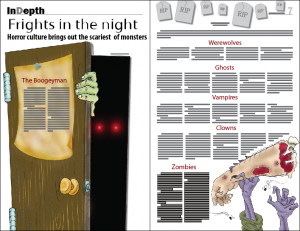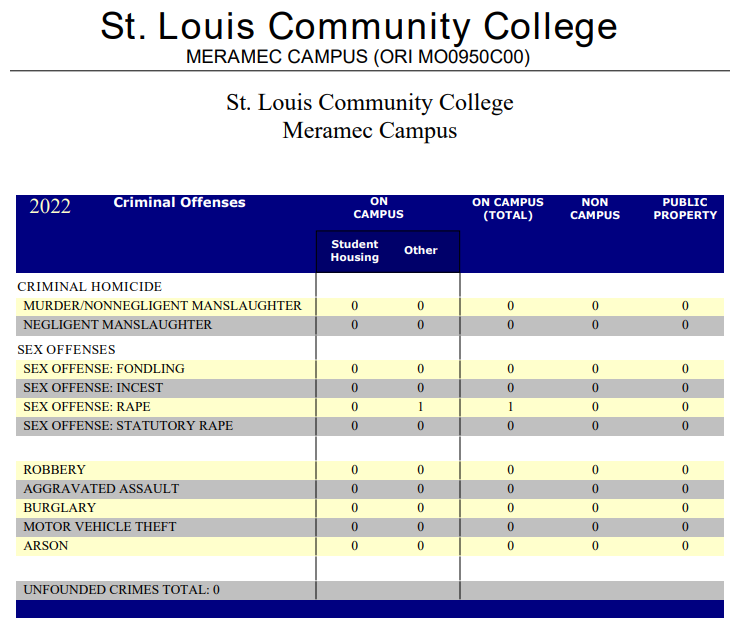
Horror culture brings out the scariest of monstersStephanie Stough
-Managing Editor-
Trying to account for all the different types of monsters, demons and beasts that haunt in the night may or may not be impossible. For those who have an imagination, these creepy creatures have developed over time through the media to continue making the hairs on the back of necks stand up and arise goosebumps everywhere. Some of these frightening monsters evolved from urban lengends and old crime stories from hundreds of years ago. Regardless of their origin, these imaginary and real horrors will continue to haunt dreams for years to come.
Werewolves
According to legend, the first werewolf to terrify villages took place in the 1500s. Peter Stubbe, known as the “World’s First Werewolf,” would haunt and murder men and little girls in German small towns. According to http://trutv.com, he was known to disguise himself as a wolf and feast on humans, such as pregnant women and their unborn children.
More than 500 years later, werewolves haunt pop culture in books and movies. The first film about werewolves, “The Werewolf,” premiered on the screen in 1913 and according to http://werewolf-movies.com, there have since been hundreds of films dedicated to this half-human/half-wolf creature that all started with the Stubbe urban legend.
Hollywood could be the blame for making werewolves less threatening after the “Twilight” novel and films portrayed werewolves as romantics.
Ghosts
A ghost is “the soul of a dead person, a disembodied spirit imagined, usually as a vague, shadowy or evanescent form, as wandering among or haunting living persons .”
No one can prove that ghosts exist and it could be up for argument whether or not ghosts have been lurking in the dark since the beginning of time, but that isn’t going to stop people from being scared of them.
Ghosts are the subject of haunted tales due to the mystery that lies behind what happens to the dead.
There are several different theories of where ghosts come from and why they linger around the living, such as they have unfinished business on Earth or refuse to move on to the next world but ghosts have been a part of history since Ancient Mesopotamia, Ancient Egypt and even in the Bible.
According to http://monsterous.com, people living in Ancient Mesopotamia believed that the ghost took form at the moment of death and the Egyptians believed ghosts lived in a subterranean world where they communicated.
Today, ghosts are the subject of countless horror films and still remain a mystery to those still in the living world.
Vampires
These blood-sucking humans have been haunting nightmares since the 1800s when the novel “Dracula” was published by Irish author Bram Stoker.
According to http://monstrous.com, this novel was based on the life of Vlad Dracula, a Romanian prince in the 1430s.
Dracula means “son of the Devil” in Romanian language.
Dracula and other vampires have submerged popular culture since the first horror movie “Nosferatu” spooked audiences in 1922. Vampires have been in the spotlight after the “Twilight” saga started the beginning of a blood-soaked trend that resulted in shows like “True Blood” and “The Vampire Diaries.”
Extreme vampire enthusiasts even practice rituals in a vampire subculture that were introduced to them through popular literature, such as Anne Rice’s “Interview with a Vampire.”
These self-proclaimed vampires congregate in bars and clubs and also dress in lots of dark clothing and wear fake fangs.
The adaptation of vampires vary based on authors and directors.
For example, they are allergic to garlic and have no reflections, but the one thing remains the same, they want blood and they want it now.
Clowns
Whether or not they are sporting a smile and oversized shoes or an evil grin and a weapon, enough people are afraid of clowns that it’s been dubbed “Coulrophobia.”
Coulrophobia is the fear of clowns or mimes and is usually diagnosed to people who have been scared of clowns since they were a young child.
Media depictions of clowns over time have given these children’s entertainers an evil image, such as Pennywise, the evil clown from Stephen King’s novel and film “It” and the clown from “Poltergeist.” Children and adults alike might associate all clowns as being evil because of such portrayals.
According to BBC News Online, in a study 250 children were asked if clown paintings were scary to them and most of them found them frightening.
Aside from a fear-provoking image and media representations, one man, John Gacy, used acting as a clown as a way to get closer to his victims, all 33 of them. Gacy, also known as “the Clown Killer,” entertained at children’s parties as Pogo the Clown. With such dark and scary representations of clowns in the popular culture, one could raise suspicions on what’s really going on behind that painted on smile.
Zombies
“Dawn of the Dead,” “Night of the Living Dead,” “Return of the Living Dead” and “The Crazies” are all examples of films that have taken the fear of the dead coming back to life and brought it to the big screen.
Zombies are bodies of dead people that give the semblance of life, but are unable to speak and will-less and usually live for some evil purpose.
According to an article published in the Los Angeles Examiner, the word zombie originated in the Africa Voodoo religion, which means departed spirits or ghosts.
The Voodoo believed that a zombie was a body without a soul that was brought back to life by a Voodoo sorcerer and was just a living corpse.
These lifeless creatures became feared by the masses in 1968 after the success of George Romero’s film “The Night of the Living Dead.” This film was followed by his other blockbusters such as “Return of the Living Dead” and “Dawn of the Dead.” In present day, there are books dedicated to surviving a zombie attack, such as “The Zombie Survival Guide” by Max Brooks and movies such as “Zombieland” and the TV series “The Walking Dead” are dedicated to what it would be like to survive a zombie apocalypse.











